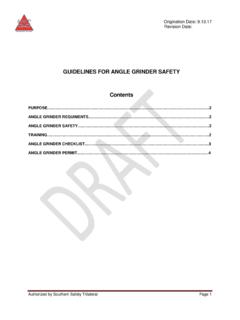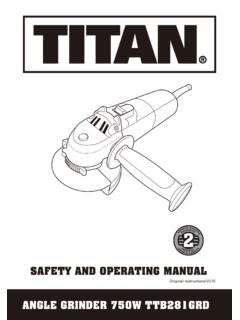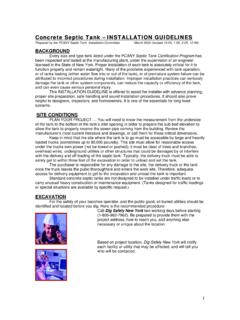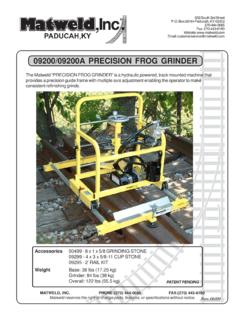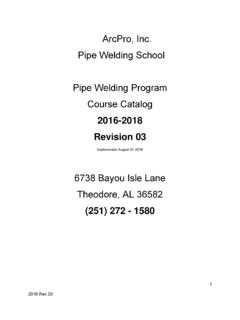Transcription of Sharpening Your Woodturning Tools - tornoartesano.es
1 Recommended Resources: AAW Sharpening Video (available in the Club s video library) Allan Batty s Woodturning Notes (available from Craft Supplies) Club mentors (names in the newsletter) Sharpening Tools : Sharpening your Woodturning ToolsJoe FlemingSan Diego Woodturners Page Updated: 0/ 4/2004 Necessities: Grinding wheel ( white friable wheel) Grinding platform/table Wheel dresser Eye protectionNiceties: Diamond flat hone Diamond cone hone Grinding jig ProtractorSharpening Procedure (freehand or jig):1. Adjust grinder platform and/or Place your tool on the grinder platform or in the grinding Place the tool in the required grinding position for that tool (and jig).
2 4. Place your body in a position so that you can start AND finish the grind. 5. Rehearse the grinding motion before turning on grinder to insure that your body is correctly Put on safety glasses or face Turn on grinder and Hone edge if Angles for Various Tools :Roughing gouge 40 90 Skew Parting tool San Diego Woodturners Page 2 Updated: 0/ 4/2004 Sharpening your Woodturning ToolsJoe FlemingShallow-fluted (spindle) gougeScrapersSharpening your Woodturning ToolsJoe FlemingSan Diego Woodturners Page Updated: 0/ 4/2004 Deep-fluted (bowl) gougeSharpening your Woodturning ToolsJoe FlemingSan Diego Woodturners Page 4 Updated: 0/ 4/2004 Burrs and Honing your Tools .
3 Grinding produces a burr of coarse metal on the top edge of the tool . This burr can be an effective cutting edge in its own right. It can also lead to inconsistent results for clean cuts for some types of woods. Honing will remove burrs when desired. Honing will also refresh a cutting edge so that you don t have to go back to the grinder every time the edge gets are some general guidelines concerning burrs and honing: Using a diamond hone along the cutting edge can usually freshen up all Tools once or twice be-tween grindings. Leave burrs on all gouges and parting Tools . The burr will be quickly removed by normal turning operations anyway so don t bother removing them. Leave burrs on skews.
4 Again, the burr will be quickly removed by normal turning operations. Because the skew makes such a fine cut, though, some people really like to remove the burr. (I personally don t). For softer woods (maple and softer), leave the burr on scrapers. For harder woods, like exotics, hone the burr off scrapers. If you want to use the burr specifically for shear scraping, hone the grinding wheel burr off, then use the hone to raise an even burr along the cutting edge. This is typically done to scrapers and bowl gouges. Not all people bother doing a new gouge for initial Sharpening : The first question to answer when setting up a gouge for grinding is far back you want to grind the wings of the flute for the swept-back style of grind.
5 This question must be answered for either freehand or If you only use the platform, set the nose angle to the desired angle (Stewart Batty recommends about 40 degrees) at the front of the gouge, with the flute straight up. Grind the gouge until the grind marks reach from flute to outer edge of the bar. Next, turn the flute to face the wheel and the gouge at 90 degrees to the wheel. Angle the gouge such that you grind off the wings with this grind. A good starting angle is around 45 degrees. Grind until the flat area just touches the nose bevel. At this point, you will have a flat surface on the entire edge of the flute all the way around the cutting surface. It will look like a horseshoe. Sharpening your Woodturning ToolsJoe FlemingSan Diego Woodturners Page Updated: 0/ 4/2004 Freehand grinding a gouge with just a flat platform for support:Now, place the gouge bar flush on the Wolverine table/platform.
6 For the rest of the operation, you will maintain a flush contact with the platform. Support the tool in both hands with one thumb pressing on the flute near the nose and the other supporting the tool at about the ferrule. Don t hold the tool any farther back on the handle or you will tend to lift the gouge off the table. The grinding operation is to start with the flute straight up. Swing the handle in an arc with the nose in continuous contact with the wheel. At the same time as you swing the gouge, you will roll the flute over toward the direction of the swing. Swing the tool back to straight on the wheel and flute straight up. Continue the swing through to the other side of the platform and rotate the flute into the swing on that side.
7 Ideally, you can start at one wing and swing the tool entirely through the motion to the other wing without interruption, hesitation or stopping. This is difficult to do because of the length of the gouge and the body positions involved. Practice the motion several times without actually grinding. By doing this, you will find the best grips and body positions to complete the whole motion. Now you are ready to grind. If you recall the horseshoe-shaped flat that you ground on top of the flute earlier. Consider this surface the shiny surface. your grinding mission is to swing the gouge through the above motion and grind the bevel until the shiny spots are all gone on the entire u-shaped profile. You will probably have more grinding to do on the wings than the nose.
8 A light touch on the nose section is recommended. Wolverine or True-Grind jig set-up and use on Spindle Gouges and Bowl Goug-es:The steps listed at the beginning of the handout are generic for freehand and jig Sharpening . For using the Wolverine s Vari-Grind jig or the True-Grind, the procedure is straight forward. Please read each instruction manual for installation and set-up details. For any other fingernail grinding jig, the principles here are identical. The procedure is the same for any fingernail grind bowl or spin-dle gouges. Only the angles may setting up the grinder, if you are Sharpening the tool for the first time, you need to grind the wings back on the flute side of the tool . For bowl gouges, the angle between this grind and the bot-tom of the flute is about 40.
9 For spindle gouges, this angle is about 30 . You can grind the tops of the wings flat or with a swept-back arc to leave a swept-back wing on the your Woodturning ToolsJoe FlemingSan Diego Woodturners Page Updated: 0/ 4/2004 Sharpening your Woodturning ToolsJoe FlemingStep 1: Insert tool into jig the recommended distance. Fix a stop block on your grinding station to make this step Wolverine: 1-3/4 Woodcut True Grind: 2 Step 2: Temporarily set the pivoting arm of the jig in approximately a 45 position to the handle of the 3: Put the jig in the sliding bar holder. Loosen the bar. Rotate the tool so that the side wing of the flute is against the grinding wheel. This will be with the flute pointing to the left or right.
10 Slide the bar in or out to achieve the desired wing grind angle. Lock the bar in 4: Rotate the tool so that the flute is straight up. Loosen the pivoting arm of the jig and set the nose angle to the desired grinding angle. Lock the pivoting arm in 5: Repeat Step 3 and Step 4 iteratively until the side angle and the nose angle are locked in place. You will likely have to make very small adjustments in both the pivot arm and the sliding bar, but they will be very 6: Scribe the pivot arm location on the jig and the sliding bar location on the bar for repeatabil-ity. A scratch awl will work for 7: Practice swinging the tool through its complete arc before turning on the grinder. Make sure your body it out of the way of the Diego Woodturners Page Updated: 0/ 4/2004 Sharpening your Woodturning ToolsJoe FlemingNote #1: When your grinding wheel wears down, the angles will gradually drift.

